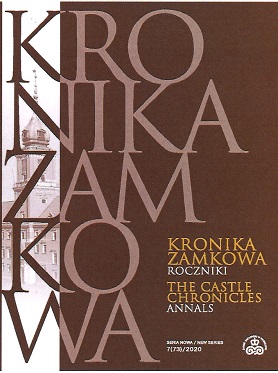Bacciarelli czy malarnia. Studium budowy technicznej portretów rodziców króla Stanisława Augusta ze zbiorów Zamku Królewskiego w Warszawie
Bacciarelli or Atelier? Study of technical structure of the portraits of King Stanislaus Augustus's Paents from the collections of the Royal Castle in Warsaw and the Łazienki Palace
Author(s): Regina DmowskaSubject(s): History, Fine Arts / Performing Arts, Cultural history, History of Art
Published by: Arx Regia® Wydawnictwo Zamku Królewskiego w Warszawie – Muzeum
Keywords: Marcello Bacciarelli; Malarnia; Portrait of Konstancja Poniatowska née Czartoryska; Portrait of Stanisław Poniatowski; replica painting; copy painting; technical structure of painting;
Summary/Abstract: Marcello Bacciarelli, soon after entering the service of King Stanislaus Augustus, became the head of an atelier, which was also a would-be academy of fine arts, known as Malarnia. Apart from educational functions, Malarnia was also obliged to execute the king’s orders, including painting and copying of portraits of the monarch and his family. In 1777, according to the written sources, Bacciarelli was to complete a large, posthumous pendant of the king’s parents, Konstancja née Czartoryska and Stanisław Poniatowski, for the Audience Chamber of the Royal Castle in Warsaw. The painter probably used unknown patterns, for example by Antoine Pesne. After the castle’s canvases a pair of reduced portraits was painted for the Łazienki Palace – a portrait of the mother, generally regarded as the work of the master with the participation of his pupils, and a portrait of the father, unanimously regarded as a copy. The two pairs were not intentionally painted together. The conservation of the four paintings and their examination by means of modern physical and chemical methods made it possible to recognise the technical structure of these canvases and revealed a number of significant, original repainting of the composition (the so-called pentimenti) in the castle pair and in the Łazienki version of the king’s mother. These alterations reveal the creative process behind the smaller image, and a comparison of the most significant details of the model’s face makes a further argument for the free, unquestionably Bacciarellian brushwork. The pentimenti of both portraits of Konstancja suggest that they could have been created at the same time. The two-stage painting process of the large pendant, revealed by the research, also allows us to assume that they might have been painted by Bacciarelli in his first Warsaw period, and later modified for the decoration of the Audience Chamber.
Journal: Kronika Zamkowa. Roczniki
- Issue Year: 7/2020
- Issue No: 7
- Page Range: 179-204
- Page Count: 26
- Language: Polish

